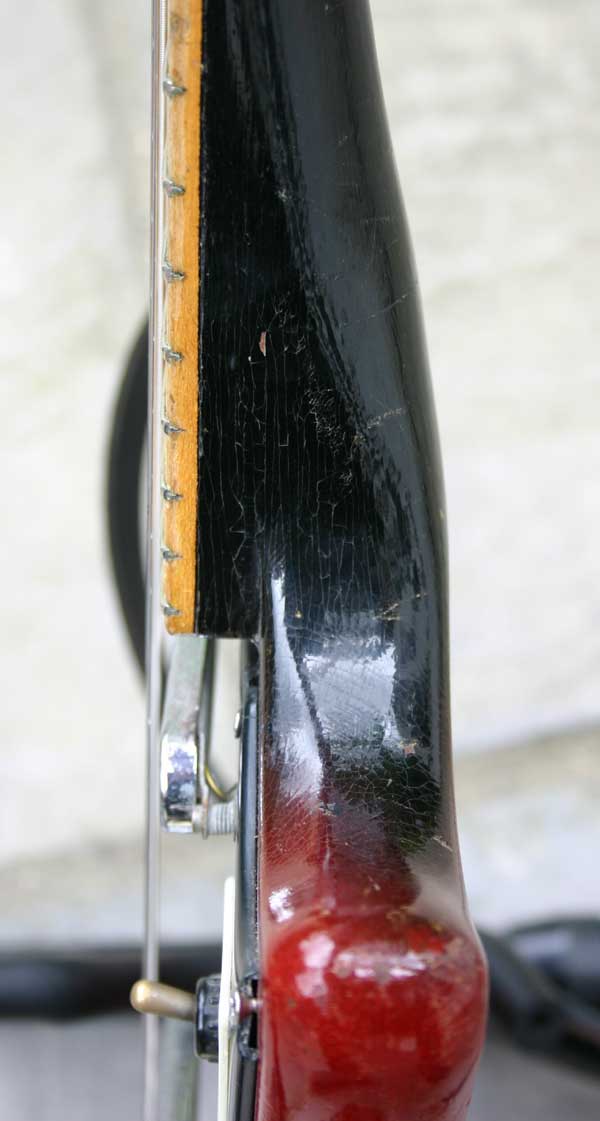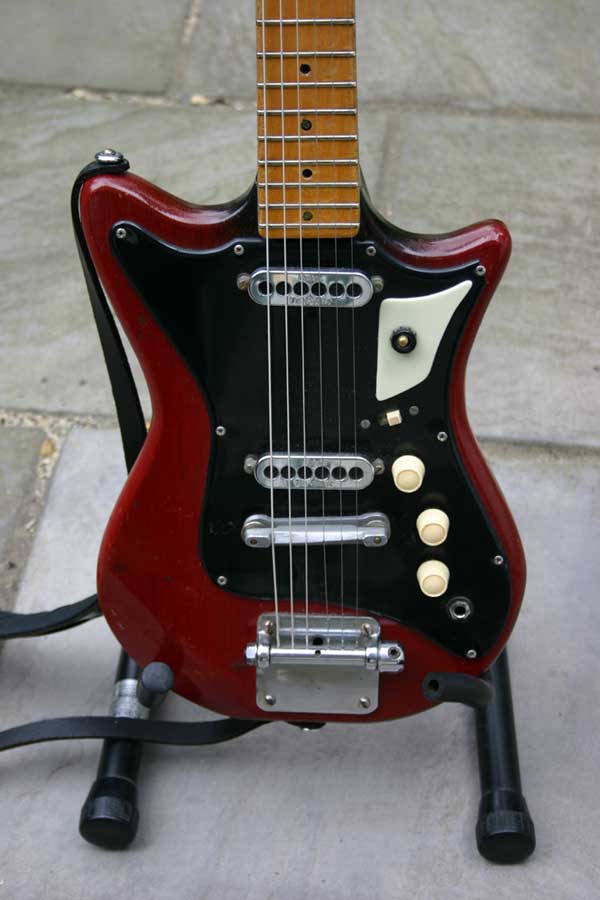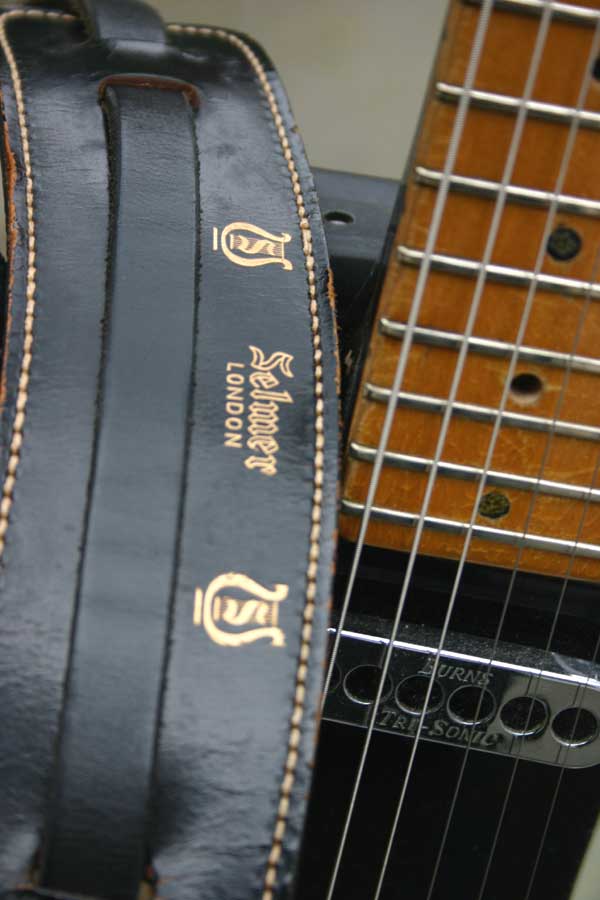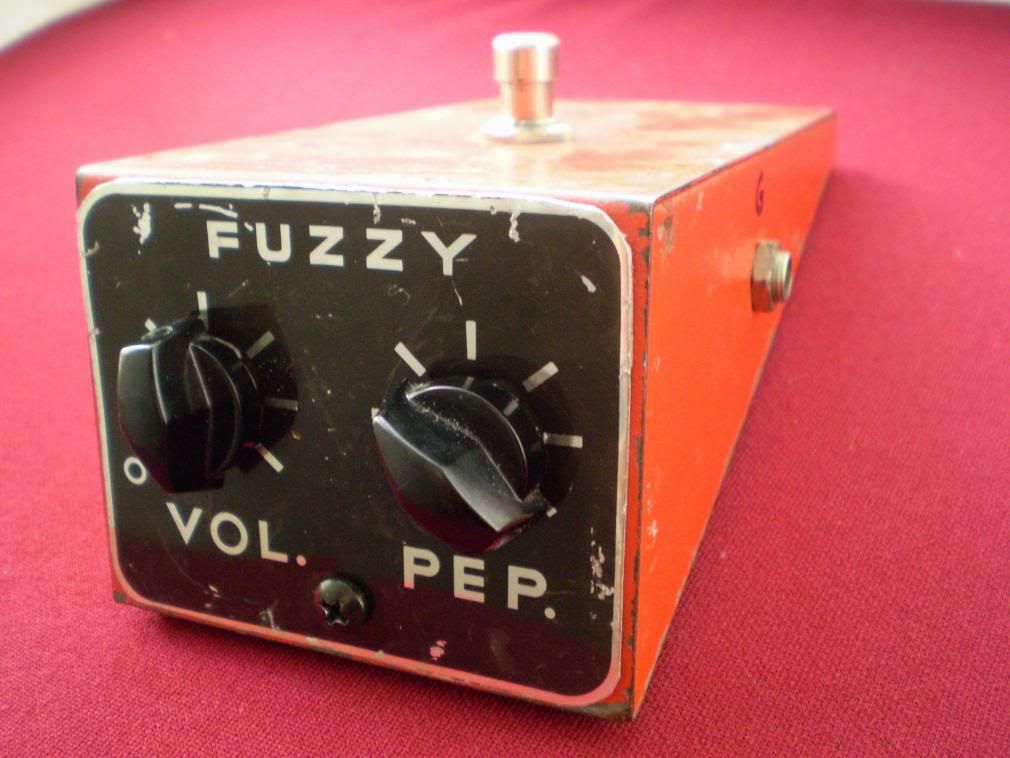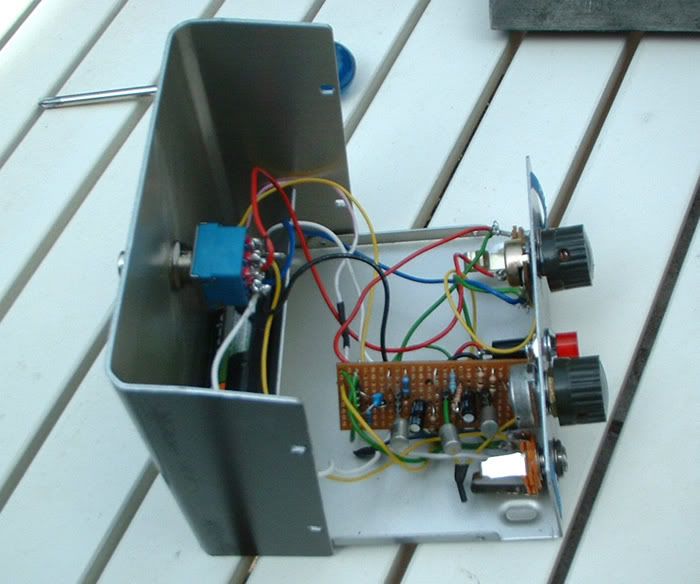 I liked them, but not sure how much. They looked brand new, so I guess they are NOS (new old stock) from the 1998-2003 Korean period, as the new Chinese ones are quite different (and quite horrible). At about £200, it was good deal but not a bargain. I took the photo and looked at it a few times over the next week, and worked out I'd have time to return on the last day and get one if I wanted, and fit it in my luggage if I took the neck off. These guitars are allegedly in the "getting hard to find" bracket if you believe dealers, but really, they are still easily found in a range of colours. I'll get a Danelectro sometime, and probably a 90s one, but this just wasn't my time.
I liked them, but not sure how much. They looked brand new, so I guess they are NOS (new old stock) from the 1998-2003 Korean period, as the new Chinese ones are quite different (and quite horrible). At about £200, it was good deal but not a bargain. I took the photo and looked at it a few times over the next week, and worked out I'd have time to return on the last day and get one if I wanted, and fit it in my luggage if I took the neck off. These guitars are allegedly in the "getting hard to find" bracket if you believe dealers, but really, they are still easily found in a range of colours. I'll get a Danelectro sometime, and probably a 90s one, but this just wasn't my time.
Monday, November 3, 2008
Den outing (no 1) - Tokyo
 I liked them, but not sure how much. They looked brand new, so I guess they are NOS (new old stock) from the 1998-2003 Korean period, as the new Chinese ones are quite different (and quite horrible). At about £200, it was good deal but not a bargain. I took the photo and looked at it a few times over the next week, and worked out I'd have time to return on the last day and get one if I wanted, and fit it in my luggage if I took the neck off. These guitars are allegedly in the "getting hard to find" bracket if you believe dealers, but really, they are still easily found in a range of colours. I'll get a Danelectro sometime, and probably a 90s one, but this just wasn't my time.
I liked them, but not sure how much. They looked brand new, so I guess they are NOS (new old stock) from the 1998-2003 Korean period, as the new Chinese ones are quite different (and quite horrible). At about £200, it was good deal but not a bargain. I took the photo and looked at it a few times over the next week, and worked out I'd have time to return on the last day and get one if I wanted, and fit it in my luggage if I took the neck off. These guitars are allegedly in the "getting hard to find" bracket if you believe dealers, but really, they are still easily found in a range of colours. I'll get a Danelectro sometime, and probably a 90s one, but this just wasn't my time.
Monday, October 6, 2008
Burns Sonic guitar, 1960 ("The Aristone")
People with an interest in guitars of the early '60s would recognise it as a Burns, but the name on the headstock is "The Aristone", so that was the main Ebay description term. Deal! Aristone were a London company who had been making banjos and ukeleles and archtop acoustic guitars since the 1930s. I've seen one other electric guitar with the same headstock logo, a late 50s semi-acoustic, on sale for a huge sum at Andy's Guitar Workshop in the year they went into liquidation. How Aristone were related to Jim Burns is a mystery, but there's no sign of any other markings, and in every other respect it's a straight-up 1960 Burns Sonic - complete with maple fretboard, white plastic knobs, army surplus 3-way switch and first-stab trem system. My only guess is that if you're starting out trying to sell guitars and nobody knows your name, you might strike a deal to use a bigger name, even if they are best known for banjos. A lot of companies were testing the water of the future beat tidal wave, and Aristone must have been one of them. Whatever the arrangement was, it didn't last. The only other clue is that the word 'foreign' appears at the bottom of the logo - maybe it was an export model.
The tuner covers reveal another unusual detail. Guitar nerds will recognise these as Van Gent tuners from the Netherlands, but they are also stamped with the logo of their British distributors, Boosey & Hawkes. I've seen these on some 1950s Grimshaw guitars online, but mostly they are plain.
It's a funny looking thing, badly designed in some ways and brilliant in others. The major problem is the weight of the neck/body joint versus the tiny, admittedly kind of silly-looking body. I had a friend in a band in the grungeful early 90s. He was a very small person and my first thought seeing him playing it was that he must have chosen it to match his stature. I was plain wrong (and probably size-ist), but with this design, how could it be anything other than neck-heavy? This photo also shows up the brittle hollow scratchplate and military grade switch.
You see some examples with the strap button moved to the lower bout, to move the centre of gravity, but this one has stayed as Mr Burns (tee hee) intended. Balance problems come into perspective when you plug it in - theses are really great pickups, maybe even better than the Valco single coils I love, so why not just sit down if its a problem? They really bite - a very punky spiky beat sound, but with a smoother mid-range and a good growl in the bass. Yay! This the best guitar for fuzz ever.
I mentioned the trem system above and you might be thinking 'what trem system?' I took the 'pat. pending' arm off and disabled it to get the action a bit lower, but the pieces are all safe. It didn't work too well in the first place. I also reversed the polarity of the bridge pickup, for more usable sounds. Originally the pickups were out of phase, which made for a strange hollow sound in the middle position that I didn't like. I changed it, but to me it's an improvement. It's been through the wars a bit, so I don't mind making a few positive alterations. To me it's still a working instrument.
One last thing I should mention is the Selmer strap. This was another ebay find - it didn't come with the guitar, but it's a good match. American collectors call this kind of thing 'case candy'. I could never use that expression, but I don't have the case either.
Sunday, October 5, 2008
Tim Escobedo's Uglyface - a modern classic!
 In the DIY effects pedal world, there are clones or rare pedals, and there are home projects that become retail Product, and there are pedals that exist only in the pure DIY realm, because they are too weird or horrible-in-a-good way to have mainstream commercial potential, like the Uglyface. Guitarists are conservative as a group (= market). Tradition weighs heavy on their shoulders, and their music is boring. Most of them don't want a pedal that makes their guitar sound like a raygun. I didn't record this clip (Tim did), but it gives you a good idea of what this thing does. Here's another , from homewrecker/runoffgroove - if this doesn't get your attention, then we can't be friends.
In the DIY effects pedal world, there are clones or rare pedals, and there are home projects that become retail Product, and there are pedals that exist only in the pure DIY realm, because they are too weird or horrible-in-a-good way to have mainstream commercial potential, like the Uglyface. Guitarists are conservative as a group (= market). Tradition weighs heavy on their shoulders, and their music is boring. Most of them don't want a pedal that makes their guitar sound like a raygun. I didn't record this clip (Tim did), but it gives you a good idea of what this thing does. Here's another , from homewrecker/runoffgroove - if this doesn't get your attention, then we can't be friends.
 I built it from scratch on plain board with holes, called perfboard, or just perf. This is one of several building methods, and it's probably my least favourite. I don't use it much, but there was (and is) a perf layout of the Uglyface at homewrecker.com. It was one of my first builds beyond the basic fuzz circuits and I didn't really know what I was doing exactly at the time, but I put it together paint-by-numbers style. it took a while to get it right, but I got there in the end. The trickiest part for me was the Vactrol, which adds the envelope follower wah-type sound. I colour coded the wires carefully and made notes, so I wouldn't get too mixed up, and left myself plenty of space.
I built it from scratch on plain board with holes, called perfboard, or just perf. This is one of several building methods, and it's probably my least favourite. I don't use it much, but there was (and is) a perf layout of the Uglyface at homewrecker.com. It was one of my first builds beyond the basic fuzz circuits and I didn't really know what I was doing exactly at the time, but I put it together paint-by-numbers style. it took a while to get it right, but I got there in the end. The trickiest part for me was the Vactrol, which adds the envelope follower wah-type sound. I colour coded the wires carefully and made notes, so I wouldn't get too mixed up, and left myself plenty of space.
 So what is it? The clips should tell you all you need to know, but if I had to describe it, I'd say it's kind of like a fuzz, but instead of just taking the wave form from your guitar and amplifying/clipping it to make a square wave (like most fuzz/distortion boxes), the Uglyface takes your signal in on one side, but what comes out of the other side is a whole new signal that tracks the changes in a fuzzed out version of the input signal, but can't follow it exactly, or reproduce its complexity, so what you hear is a big wall of glitchy, synthy guitar noise. I love it. The basic envelope follower makes it even less guitar-like. Certain settings will get you the Star Wars thing going.
There are a couple of ther DIY circuits that apparently have some similarity to this floating around - John Hollis' Crash Sync /Auto Crash and the 4ms Noise Swash, but this is the simplest to build, and best documented. There have been stripboard layouts and a modification or two in the last couple of years. Tim Escobedo rules. I can't help forming mental images of people I've never seen; I imagine Tim has short-ish dark hair and a full but closely cropped beard, a bit like David Fair from Half Japanese perhaps.
So what is it? The clips should tell you all you need to know, but if I had to describe it, I'd say it's kind of like a fuzz, but instead of just taking the wave form from your guitar and amplifying/clipping it to make a square wave (like most fuzz/distortion boxes), the Uglyface takes your signal in on one side, but what comes out of the other side is a whole new signal that tracks the changes in a fuzzed out version of the input signal, but can't follow it exactly, or reproduce its complexity, so what you hear is a big wall of glitchy, synthy guitar noise. I love it. The basic envelope follower makes it even less guitar-like. Certain settings will get you the Star Wars thing going.
There are a couple of ther DIY circuits that apparently have some similarity to this floating around - John Hollis' Crash Sync /Auto Crash and the 4ms Noise Swash, but this is the simplest to build, and best documented. There have been stripboard layouts and a modification or two in the last couple of years. Tim Escobedo rules. I can't help forming mental images of people I've never seen; I imagine Tim has short-ish dark hair and a full but closely cropped beard, a bit like David Fair from Half Japanese perhaps.
Tuesday, September 2, 2008
Epiphone '57 Reissue Les Paul Junior, 2007

Monday, August 11, 2008
Silvertone Artist, 1958
 This guitar was made by the Valco company of Chicago, for the Sears Roebuck department store house brand Silvertone. Valco also made the National line of guitars and amps, the ‘budget’ Supro line, and a range of brands incuding Oahu and other department store house brands like Airline for Montgomery Ward. It has some similarities to the Supro Rhythm Tone and Belmont models of the late 1950s, with a different headstock, scratchplate/pickguard and tailpiece. The serial number X86897 puts it in early 1958.
This guitar was made by the Valco company of Chicago, for the Sears Roebuck department store house brand Silvertone. Valco also made the National line of guitars and amps, the ‘budget’ Supro line, and a range of brands incuding Oahu and other department store house brands like Airline for Montgomery Ward. It has some similarities to the Supro Rhythm Tone and Belmont models of the late 1950s, with a different headstock, scratchplate/pickguard and tailpiece. The serial number X86897 puts it in early 1958.
 Valco also made a two-pickup solid body guitar for Sears /Silvertone in 1958, much like the first version of the Supro Dual Tone. For some reason the two Valco guitars were given the same model name by Sears - The Artist, with the same distinctive ‘electric cowboy’ headstock logo. On the two pickup version it’s silver, on the single pickup one I have it’s gold. There aren’t many Valco-made Silvertones around, and they don’t seem to have lasted long enough to get into one of their famous mail order catalogues.
Valco also made a two-pickup solid body guitar for Sears /Silvertone in 1958, much like the first version of the Supro Dual Tone. For some reason the two Valco guitars were given the same model name by Sears - The Artist, with the same distinctive ‘electric cowboy’ headstock logo. On the two pickup version it’s silver, on the single pickup one I have it’s gold. There aren’t many Valco-made Silvertones around, and they don’t seem to have lasted long enough to get into one of their famous mail order catalogues.
 The Artist is a basic guitar, but it feels really great to play. You hear a lot about ‘baseball bat’ necks online, but this is the real thing. I find it very comfortable to play, though my hands aren’t large - the neck is thick. but with a narrower than usual fretboard. Called the ‘Kord King’ neck in Supro catalogues, it has a ‘feather-light modern aircraft metal’ rod running down it but no tension adjustment. It has an ebony (rather than the usual rosewood) fretboard. It is worn in places and has a crack running down it, but the 19 narrow frets are in good shape. Valco moved to a 20 fret neck on most of their guitars in 1958/9. It has white block inlays rather than the dots used on the Belmont most of the lower end Supros, and It’s only really held on with one screw (with a second for neck tilt adjustment) but it feels very solid, with no wiggles. The scale is full Gibson length – 24.75”, though it looks shorter because of where the neck joins the body..
The Artist is a basic guitar, but it feels really great to play. You hear a lot about ‘baseball bat’ necks online, but this is the real thing. I find it very comfortable to play, though my hands aren’t large - the neck is thick. but with a narrower than usual fretboard. Called the ‘Kord King’ neck in Supro catalogues, it has a ‘feather-light modern aircraft metal’ rod running down it but no tension adjustment. It has an ebony (rather than the usual rosewood) fretboard. It is worn in places and has a crack running down it, but the 19 narrow frets are in good shape. Valco moved to a 20 fret neck on most of their guitars in 1958/9. It has white block inlays rather than the dots used on the Belmont most of the lower end Supros, and It’s only really held on with one screw (with a second for neck tilt adjustment) but it feels very solid, with no wiggles. The scale is full Gibson length – 24.75”, though it looks shorter because of where the neck joins the body..
 It’s been played enough to wear away most of the screenprinted Sivertone logo on the cracked and glued ‘deco’ scratchplate, but it’s original owner had the foresight to invest a few extra dollars on a hard case, which I also have, so it’s in good shape overall. The embossed cowboy motif leather strap is a nice touch – it’s an idea borrowed from Gretsch, who Valco built amps and at least one guitar for in this period.
It’s been played enough to wear away most of the screenprinted Sivertone logo on the cracked and glued ‘deco’ scratchplate, but it’s original owner had the foresight to invest a few extra dollars on a hard case, which I also have, so it’s in good shape overall. The embossed cowboy motif leather strap is a nice touch – it’s an idea borrowed from Gretsch, who Valco built amps and at least one guitar for in this period.
 The finish is a thick black plastic coating that Valco called ‘Glossy Jet No-Mar’. It hasn't bubbled up flaked off anywhere. It matches the 1958 Supro line’s ‘Dashing new color theme of Black, White and Inca Gold’. The tuners are original, but with replaced buttons. I do have a spare rosewood Valco bridge I could use, but I like the brighter sound of the Tune-a-matic, plus it’s the right colour.
The pickup is a single coil, but looks like a humbucker. Some people have assumed this is a deliberate deception, but Valco had their own patent, thanks very much, cited on Seth Lover’s later Humbucker patent documents. For a short time in the late 50s, Valco even took to printing their patent number (2683388) on the outer cover, I think to avoid confusion with the Gibson product. Most people seem to like these big single coil pickups, although there are some dissenters. A lot of people say they're 'great for slide', which is the main cliche used in describing Supro, National and Airline guitars. They are not super-loud, but they distort a little even at low volume through a clean amp, and I like that. They are often compared to P90s, but my limited experience says they have a weaker but more complex sound than a modern (GFS) P90 at least. It’s a little bassy for me in the normal channel, but sounds just right in the bright channel of my Davoli Studio 60 valve amp. Because the neck pocket is deeper than on later Valco solid-bodies, the pickup is set into the top rather than surface mounted.
It’s my favourite guitar to play when I'm just sitting around - smooth low(ish) action and the perfect weight – only 6.5 pounds (just under 3 Kg). The range of amplified sounds from the neck pickup is not huge – but it’s great for fuzz, or with a treble booster! I would love a bridge pickup Belmont or a Rhythm Tone from the same period, but they are getting expensive now.
The finish is a thick black plastic coating that Valco called ‘Glossy Jet No-Mar’. It hasn't bubbled up flaked off anywhere. It matches the 1958 Supro line’s ‘Dashing new color theme of Black, White and Inca Gold’. The tuners are original, but with replaced buttons. I do have a spare rosewood Valco bridge I could use, but I like the brighter sound of the Tune-a-matic, plus it’s the right colour.
The pickup is a single coil, but looks like a humbucker. Some people have assumed this is a deliberate deception, but Valco had their own patent, thanks very much, cited on Seth Lover’s later Humbucker patent documents. For a short time in the late 50s, Valco even took to printing their patent number (2683388) on the outer cover, I think to avoid confusion with the Gibson product. Most people seem to like these big single coil pickups, although there are some dissenters. A lot of people say they're 'great for slide', which is the main cliche used in describing Supro, National and Airline guitars. They are not super-loud, but they distort a little even at low volume through a clean amp, and I like that. They are often compared to P90s, but my limited experience says they have a weaker but more complex sound than a modern (GFS) P90 at least. It’s a little bassy for me in the normal channel, but sounds just right in the bright channel of my Davoli Studio 60 valve amp. Because the neck pocket is deeper than on later Valco solid-bodies, the pickup is set into the top rather than surface mounted.
It’s my favourite guitar to play when I'm just sitting around - smooth low(ish) action and the perfect weight – only 6.5 pounds (just under 3 Kg). The range of amplified sounds from the neck pickup is not huge – but it’s great for fuzz, or with a treble booster! I would love a bridge pickup Belmont or a Rhythm Tone from the same period, but they are getting expensive now.
 I usually avoid stickers and things on my guitars, but this a special one – the blue dot is from Tyree Guyton of the Heidelgerg Project in Detroit, and it also reminds me of the National Enquirer’s old Lucky Blue Dot. On the back, Taking Care Of Business - speaks for itself. Charlotte got this for me at Graceland. I love the Enhanced Elvis Concept of not just TCB, but TCB In A Flash!
I usually avoid stickers and things on my guitars, but this a special one – the blue dot is from Tyree Guyton of the Heidelgerg Project in Detroit, and it also reminds me of the National Enquirer’s old Lucky Blue Dot. On the back, Taking Care Of Business - speaks for itself. Charlotte got this for me at Graceland. I love the Enhanced Elvis Concept of not just TCB, but TCB In A Flash!
Sunday, August 10, 2008
Terminology (digression no.1)
Sunday, August 3, 2008
Marshall Supa Fuzz, 1967-ish
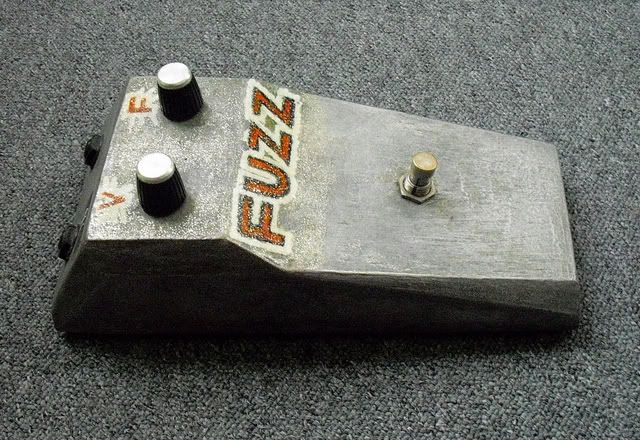
When I got it was unpainted, rough aluminium. I painted the word FUZZ on it - seemed reasonable at the time. The glitter was was probably not such a good idea, but it's only nail polish; removable. I used to laugh at the size of the components - they seemed huge. I had no idea it was anything special for about the first 10 years I had it, other than that it sounded great. Then Rob from The King Cheetah (then based in London, now in LA) told me it looked like a Marshall Supa Fuzz. I wasn't really convinced, nor did I realise the significance of this info straight away. Eventually I put a photo of it on my first website (that I never updated), and got into contact with fuzz expert Stu Castledine. I sent him some photos of the board, and noticed something odd:
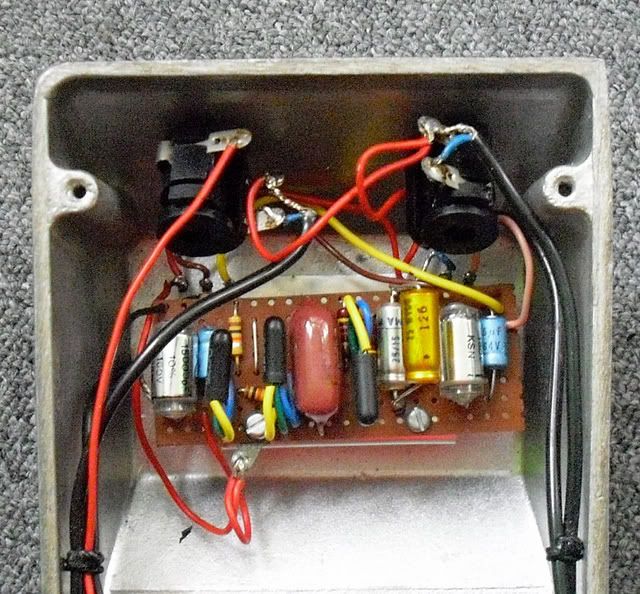
That gold thing (an elecrolytic capacitor) at the end, was on top of a smaller one (in parallel with it, even). Both are rated at 25uF (micofarads, units of capacitance, like), so that makes 50uF altogether. I considered de-soldering it, but it looked original, and Stu said he'd seen a few different values in early Supas. But if it was added at the time, wouldn't they have use two identical caps, if they just ran out of 50uF and wanted that value? Anyway, it sounds amazing, so I think I'm leaving it. I did consider some kind of switch but I don't want to touch it really. Anyone seen this before? The transistors are Mullard OC75s. Here's a clip - neck pickup of 1960 Burns Sonic. I hear a lot of clips on the internet that are just sqiddly lead runs, I don't think these give much of an idea of the sound of any given pedal and they can be painful and embarrassing to listen to - my clips are more basic, but illustrate the fuzz sound and how I'm likely to use it. This one has a bit of Black Keys in there.
Marshall Supa Fuzz
The Supa Fuzz is a close relation to the Mk2 Tone Bender, designed by Gary Hurst. For a great history of these pedals and their variants and to see where the Supa fits in, see David Main's excellent page A Little History. Dave reckons my one is around 1967, about the time of this advert:
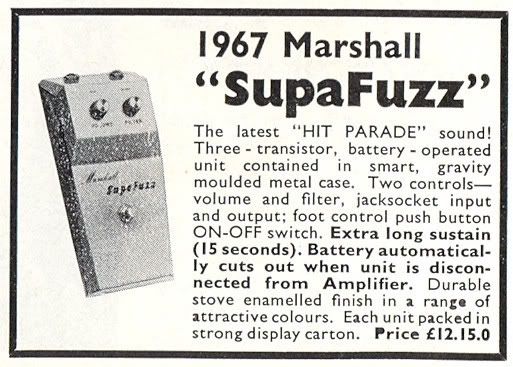
[minor edits + pics restored, Dec 2011]
Tuesday, July 29, 2008
Pepe Rush fuzz part 2
There's a picture of John Lennon in the studio recording Revolver, with a box like it. You can see the shape and a few letters that look like they might say "PEP BOX" with a WEM logo, but it's not at all clear whether this is the same thing as the red pedal which seems to have been called the Fuzzy. Nobody knows!
This photo has been discussed at length, and Beatles nerds are fairly sure it wasn't used on the finished album, so it's a bit of a mystery. Rush did make a deal with WEM (Watkins Electric Music!) to produce a fuzz pedal in 1966, but the WEM pedal that eventually came out is a flat box with wooden sides and a different circuit using the more stable Silicon transistors. The original uses Germanium transistors - they are more difficult to get to sound right, but the fuzz sound is better to my ears - smoother, looser, woollier and more compressed. Here's the schematic and stripboard (or veroboard) layout I used:
... and an interior photo:
This is slightly different from the layout, because I niftily mounted the board on the PEP control. I also added a small bulb (not an LED), so you can tell when it's on: I used Newmarket NKT213 PNP Germanium transistors - they're normally quite rare and expensive but I got lucky with a box of 20. The original transistors are unmarked, but have the same metal can package. NKT213s are also used in the Burns Buzzaround (more on that later.) The original owner of the red pedal above sold it soon after. He didn't like it, saying it was like the typical can-of-bees 60s fuzz, like the Fuzztone. I think he's more into the heavier sounding 70s pedals. I haven't heard the original, but with these transistors, it's a much fuller bassier sound than the slightly screechy (in a good way) Fuzztone, and it's also a lot louder. The PEP control behaves much like the Attack pot on the FZ1, but where the only good position on the original is full-on, the PEP pot gives good fuzzy sounds all the way back to about the 6 o'clock position. I think it's down to the transistors. I like the way it sounds now, but often I'll change them around, try different ones after a few months, as I use sockets rather than soldering them direct to the board. It's amazing how different they sound to each other. Battery access is awkward in most DIY pedals - you have to unscrew the bottom most of the time - I solved this problem by bending the back panel inwards and mounting the batteries there, on the outside - a little bit like another early guitar pedal, the Dallas Rangemaster treble boost, which is sort of the look I was after for this one. I haven't decided how to do the sound clips yet, that's for the future. There's a whole bizarre vocabulary that has grown up to attempt to describe the many sounds of Fuzz that people use on the DIY forums I spend time on. I'll try to avoid these terms, but it's hard to describe the nuances of one fuzz compared to another - it might get difficult as time goes on - I'll need the sound clips. Once I thought that all fuzz pedals sounded the same. Now I'm a fuzz geek, cursed with trying to explain why they don't all sound the same!
Wednesday, July 16, 2008
First post (Pep Rush fuzz)
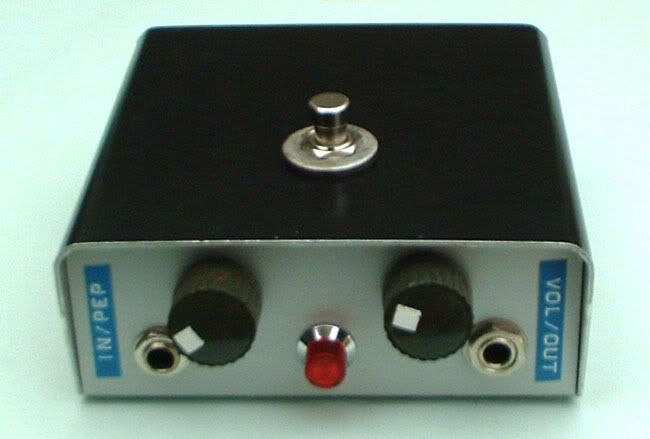 |
| Add caption |
He is still around, and for the record, he is of Russian extraction, not Italian as I originally said. The pedal is as obscure as they come, it's not even clear what the original was called, but like Gary Hurst's orginal Tone Bender, it was based on the Maestro Fuzztone, although it's a different circuit to the one Rush licensed to WEM a little later.





